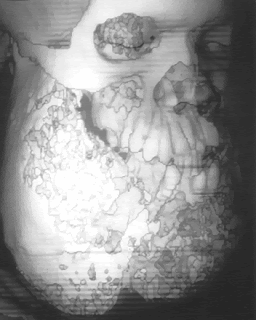Cherubism is a disease characterized by abnormal bone tissue in the lower part of the face. Both the mandible and maxilla become enlarged and the bone is replaced with cyst-like growths which are painless. These growths give the cheeks a swollen, round appearance and often times interfere with tooth development. Cherubism is a hereditary disease affecting the genes. The first signs of cherubism are usually seen in early childhood and continue to grow until puberty. The abnormal growths are gradually replaced with normal bone in early adulthood which is why most affected adults have a normal facial appearance. Cherubism rarely affects any other parts of the body unless it occurs as part of another genetic disorder, such as Ramon syndrome.
In imaging studies cherubism is similar to fibrous dysplasia especially when the excessive growth is confined to the mandible. Because of the similarities it is suggested that cherubism may be a form of fibrous dysplasia. Imaging procedures used to diagnose cherubism include CT scans and MR imaging.
Cherubism seen in a young girl with excessive growth of the mandible and maxilla.
3D Coronal oblique CT scan of a 16 year old girl with massive mandibular enlargement and difficulty swallowing.
Coronal CT scan of 16 year old girl with massive mandibular enlargement shows variable appearance of matrix, ranging from radiolucent to densely sclerotic.



No comments:
Post a Comment